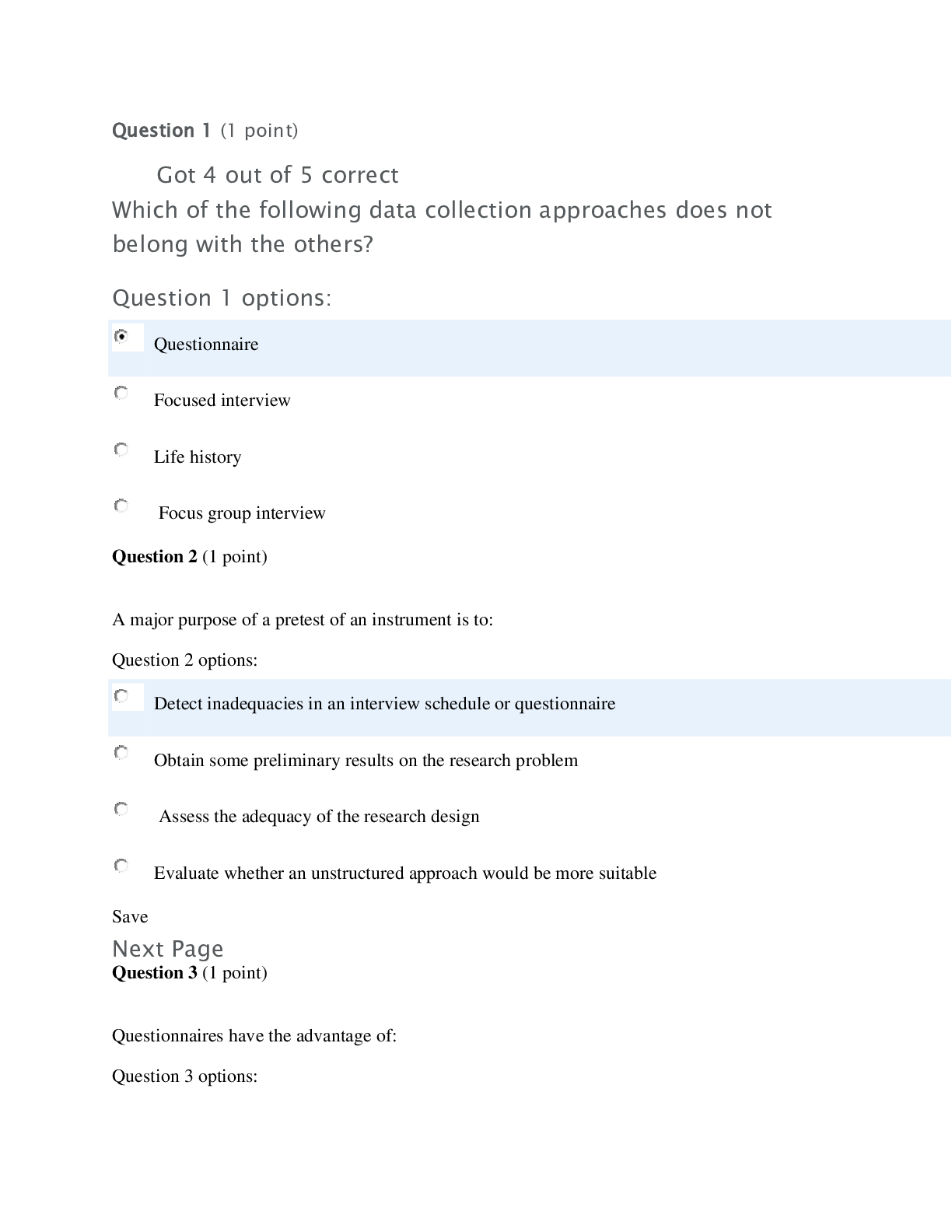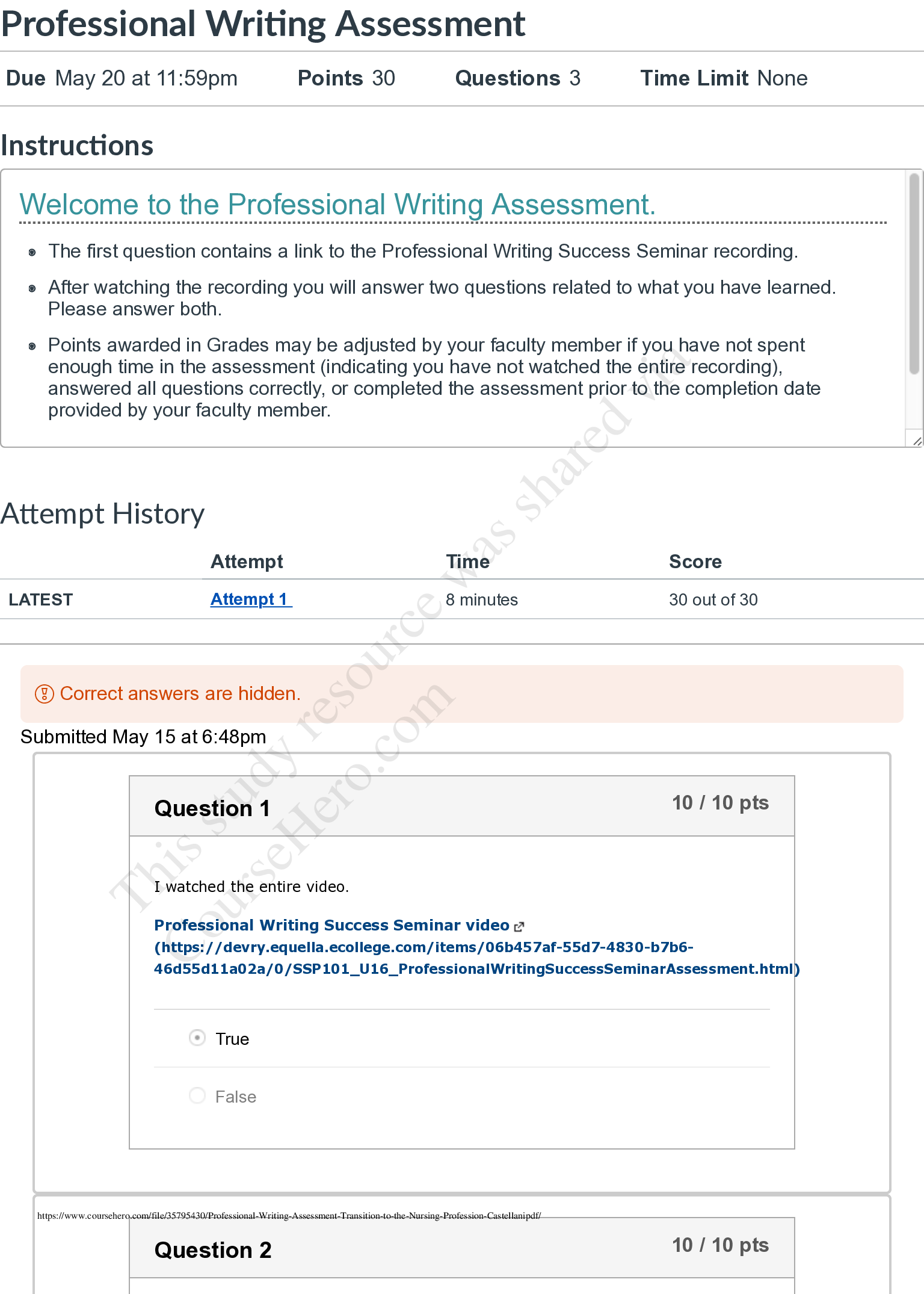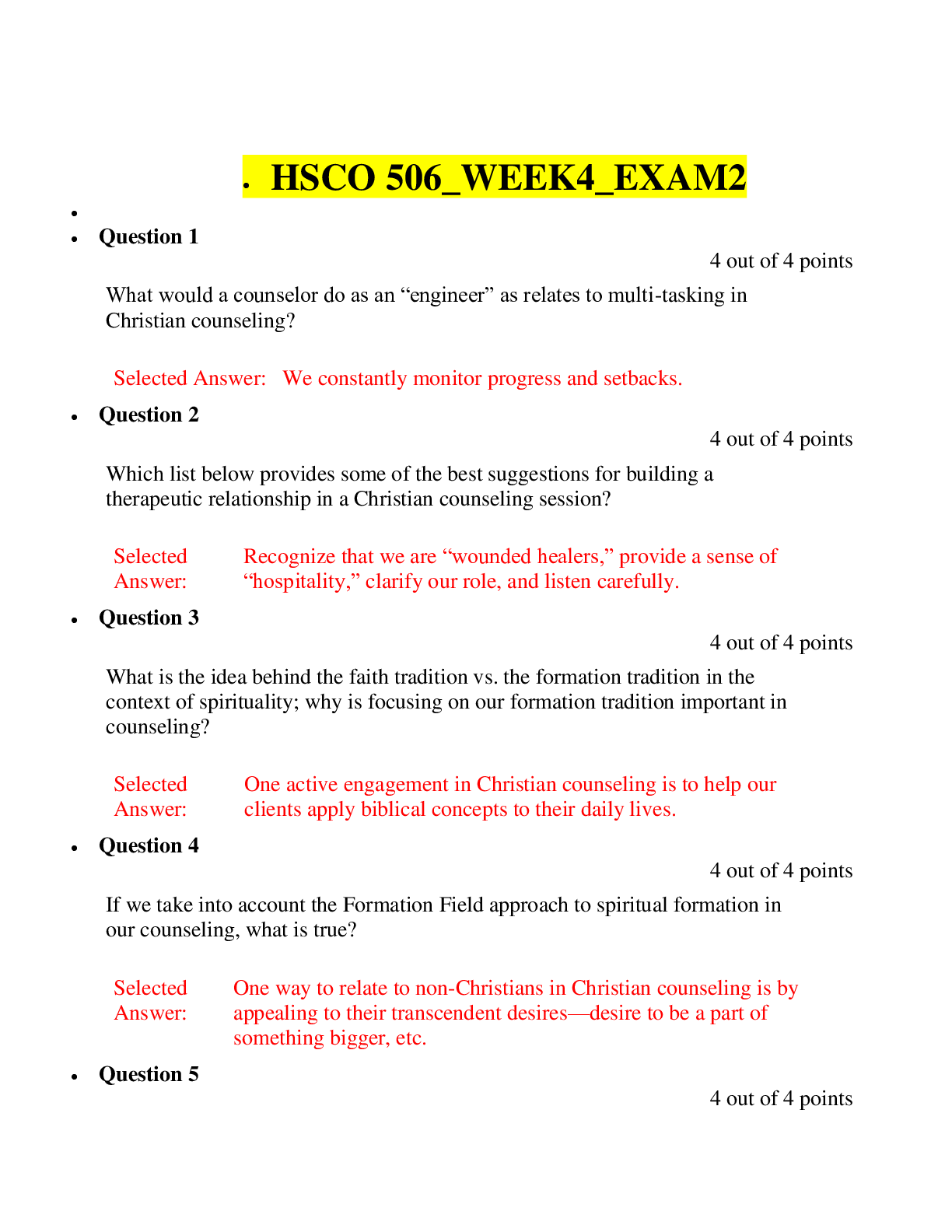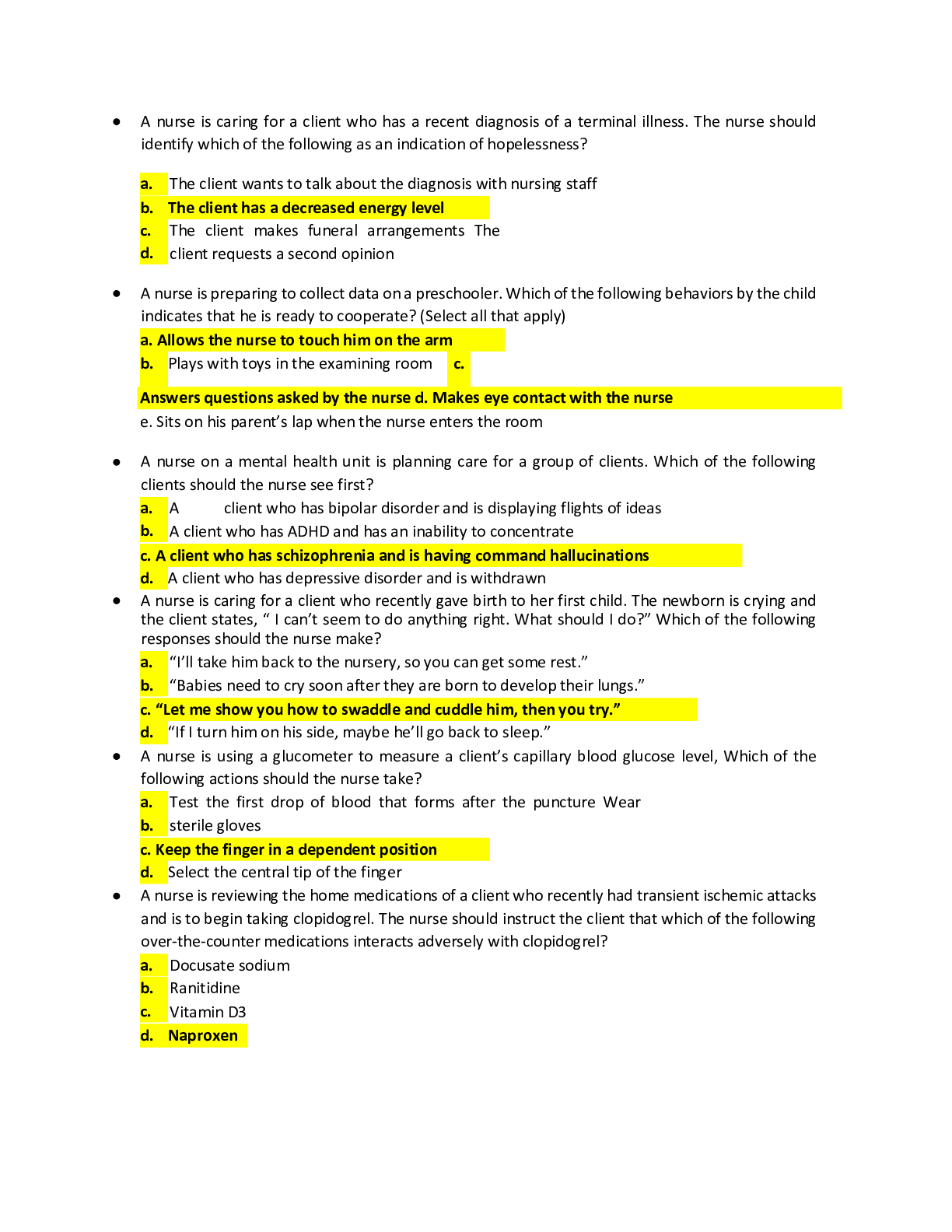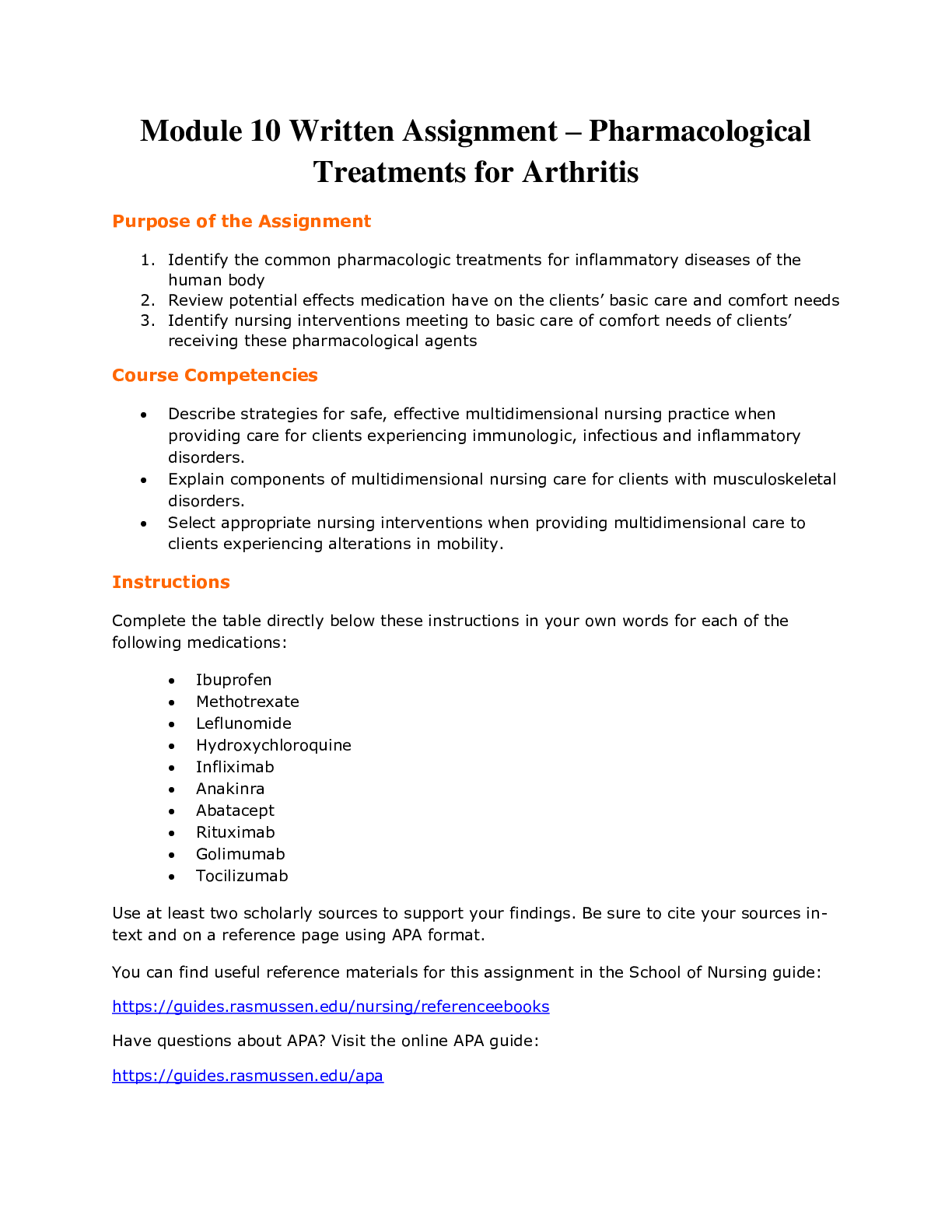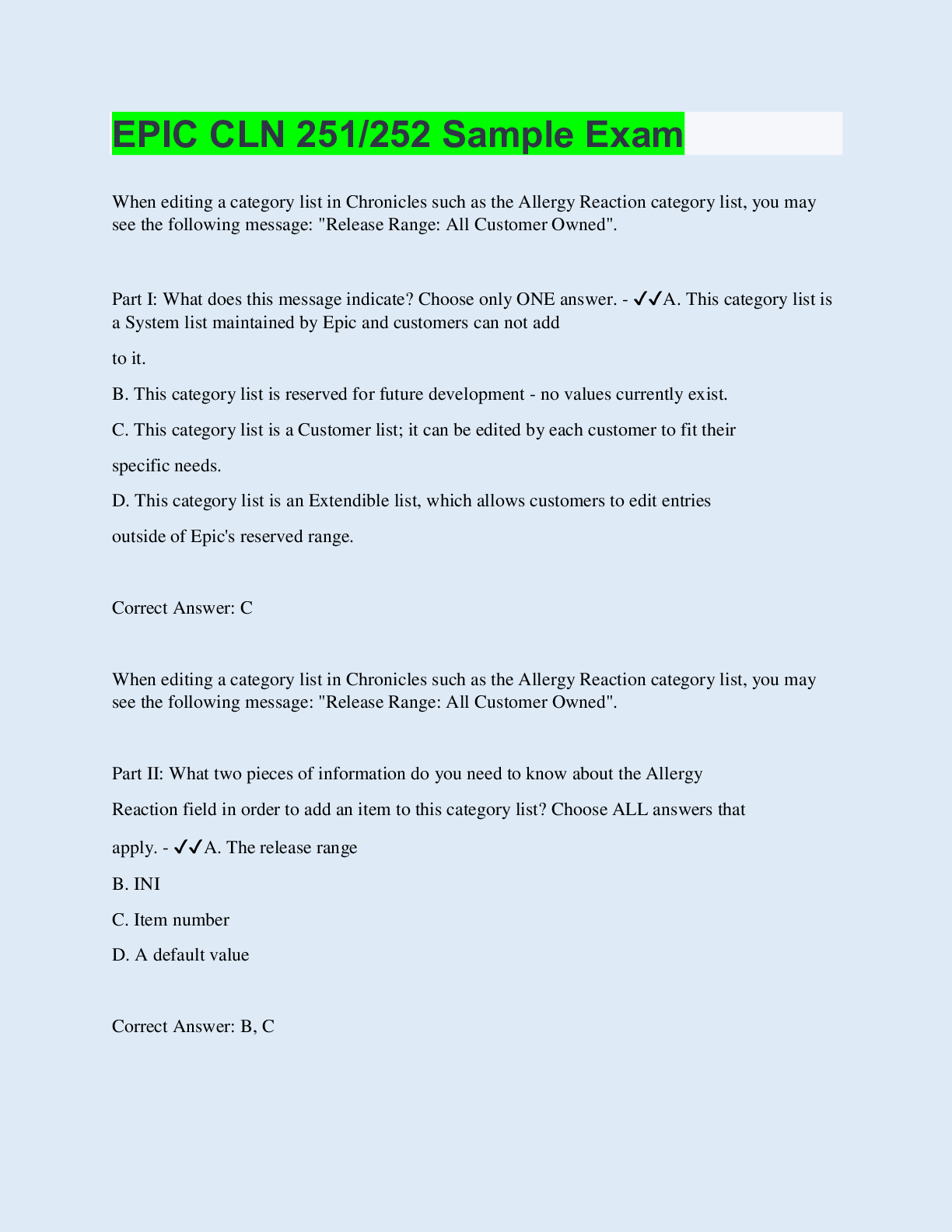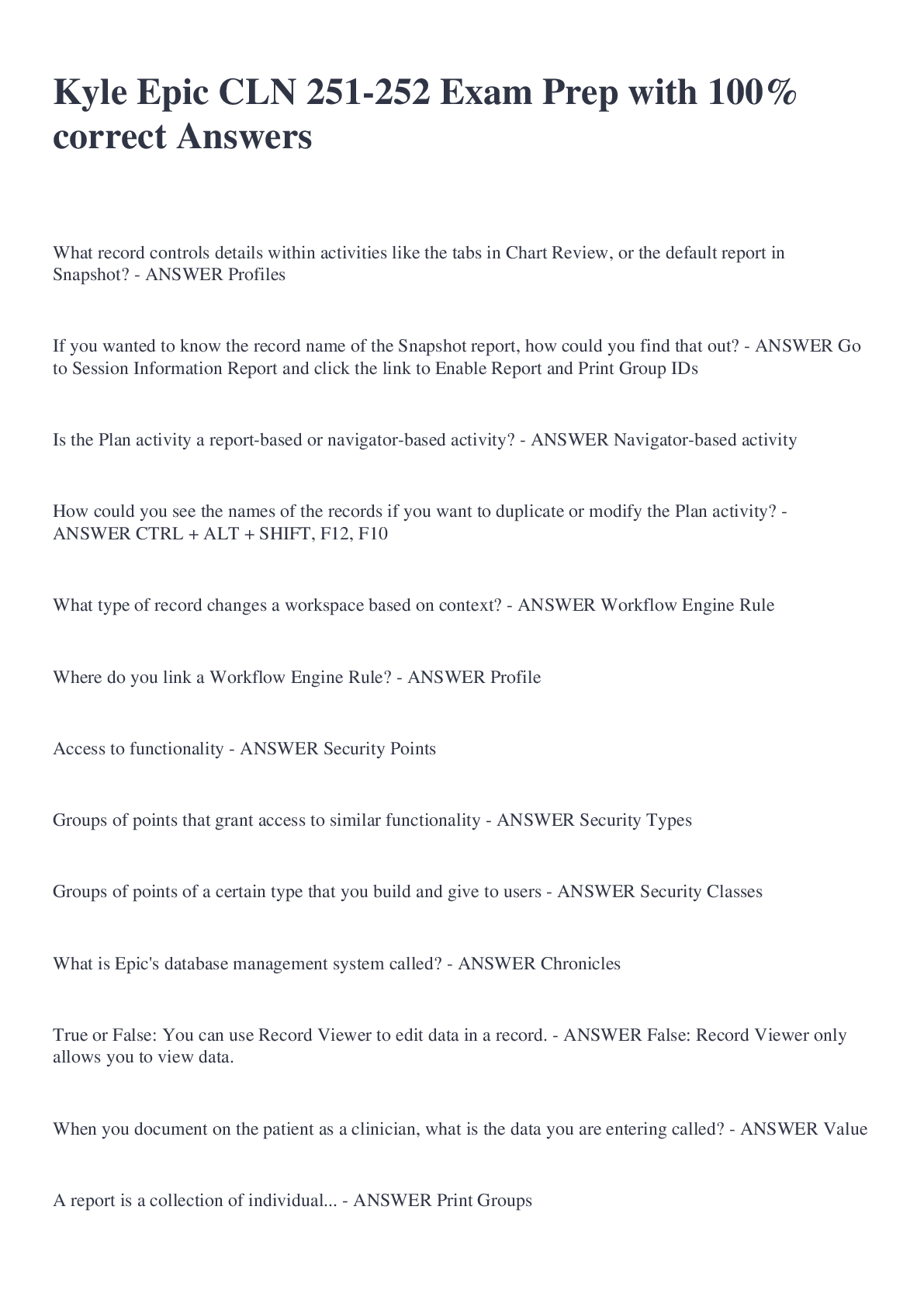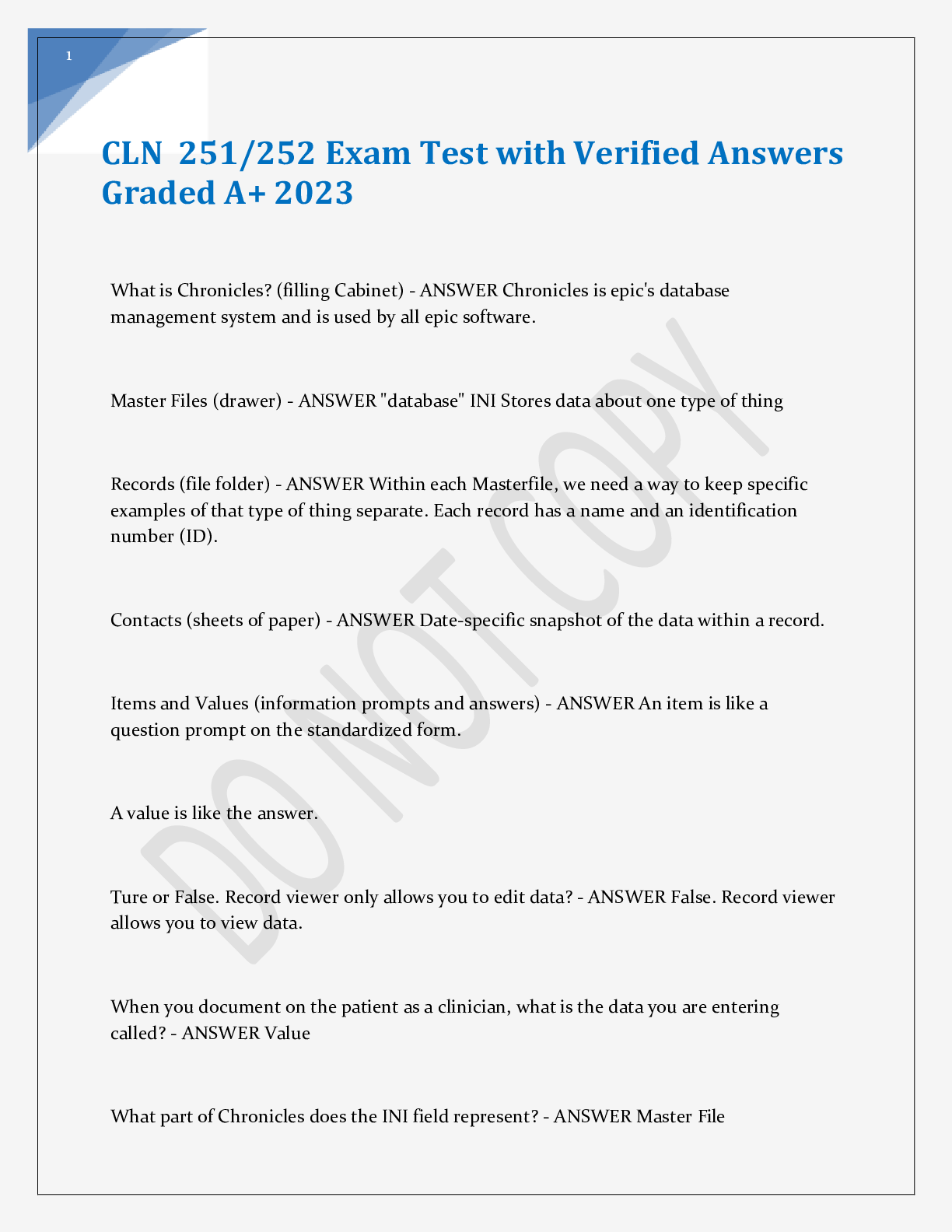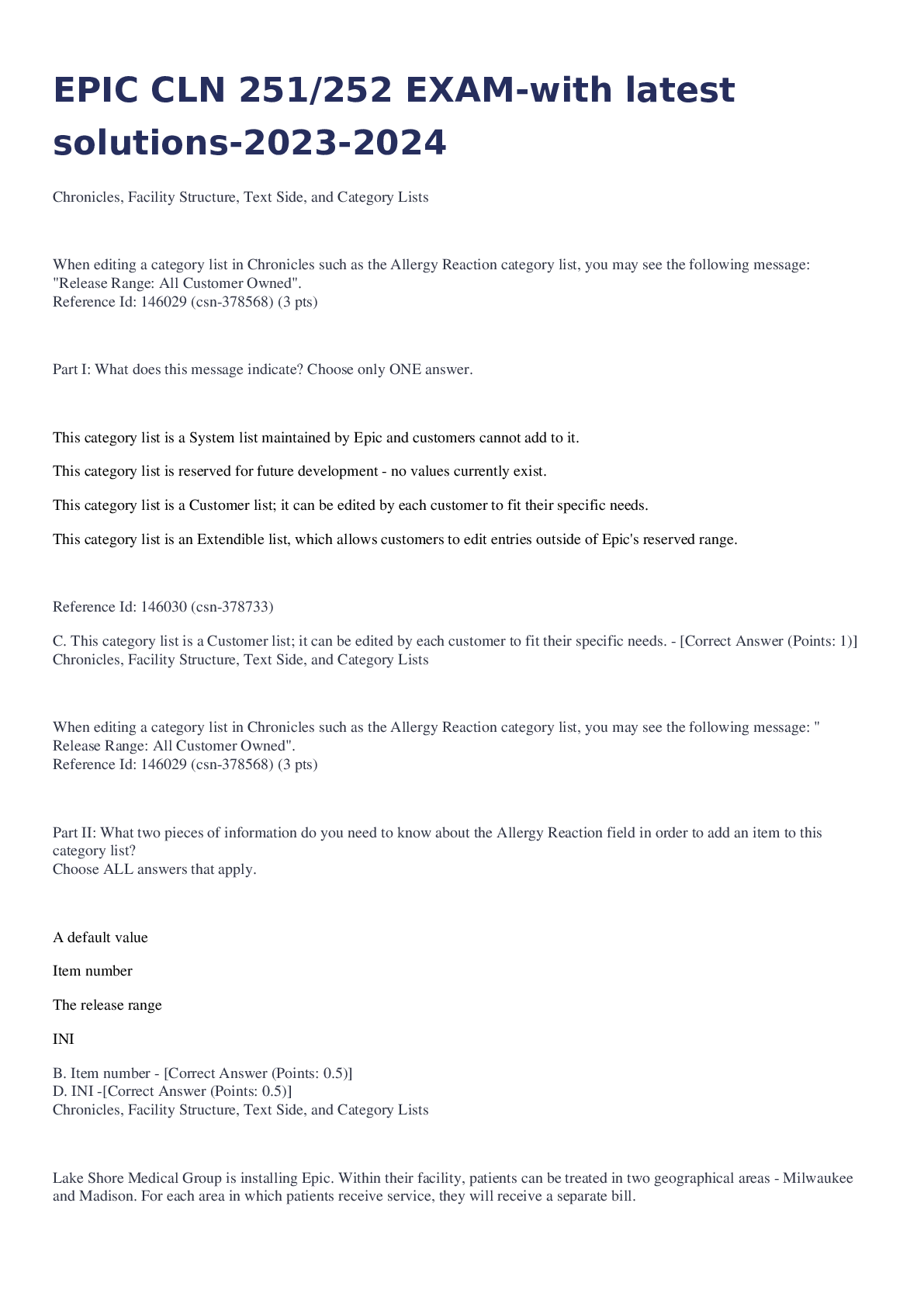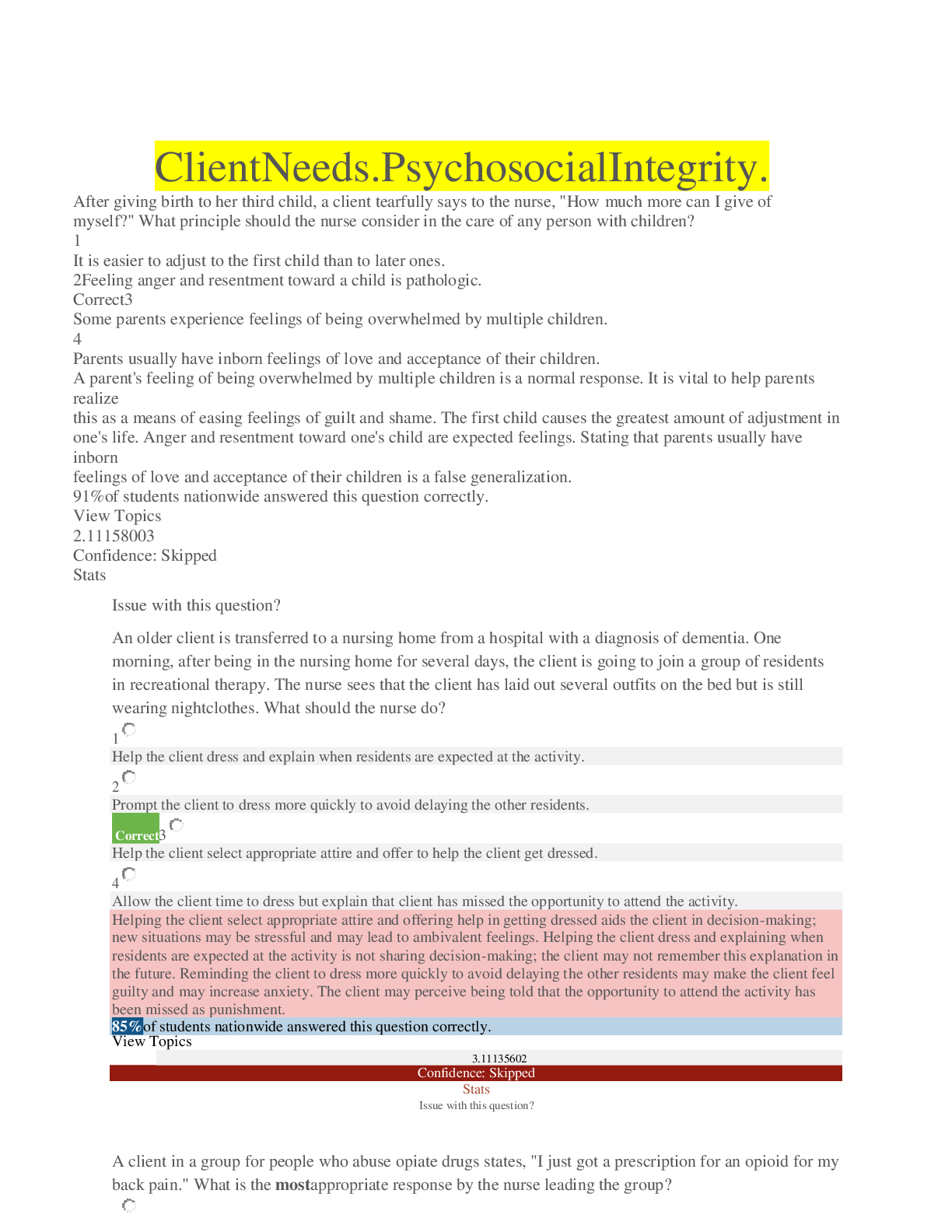Art > EXAM > Chapter 8 Children's Creative Work in Diverse Families and Communities Questions And Answers (All)
Chapter 8 Children's Creative Work in Diverse Families and Communities Questions And Answers
Document Content and Description Below
Chapter 8 Children's Creative Work in Diverse Families and Communities Highlight the correct answer. 1) Creativity is an important resource with ________ significance. A) social B) economic C... ) cultural D) all of the above 2) Gardner (1993) defines intelligence as: A) the ability to solve problems and or fashion products that are of consequence to a community. B) the ability to speak clearly C) the ability to think in a linear fashion D) the ability to respond appropriately to instructional demands E) the ability to successfully and consistently score high on intelligence tests 3) Conditions that support creativity include all of the following except: A) a stimulating environment B) overwhelming tasks C) respect for children's contributions D) supporting individual differences 4) Which of the following is a true statement about brain research? A) early social and emotional experiences are the seeds of human intelligence B) different regions of the brain are actively developing and maturing according to timetables C) children who don't play much develop smaller brains D) A and B E) A, B, and C 5) Rural Kenya uses all of the following terms to describe intelligence except: A) reiko B) winjo C) luoro D) falko E) paro 6) ________ affects creativity. A) Intelligence B) Motivation C) Learning style D) Emotion 7) All of the following tools support and inspire children's creative exploration except: A) picture books B) coloring books C) musical instruments D) scissors and paper E) recycled materials 8) Gardner asserts that schools typically emphasize: A) linguistic/mathematical intelligence B) kinesthetic/logical intelligence C) visual spatial/musical intelligence D) intrapersonal/interpersonal intelligence E) environmental/linguistic intelligence 9) Teachers are powerful in their abilities to: A) change the way parents relate to children B) function as a role model of habits of mind and work C) establish and control the social dynamics of the classroom D) B and C 10) Fear of taking a risk, of chaos, and of criticism are major deterrents to teachers': A) compliance B) responsibility C) creative thinking D) status in the community E) job expectations 11) A person who demonstrates strength with words and language would have strong: A) visual/spatial intelligence B) interpersonal intelligence C) intrapersonal intelligence D) verbal/linguistic intelligence 12) Ideally, schools should: A) have smaller class sizes B) give less homework C) integrate curriculum and accommodate to many different ways of knowing D) cultivate convergent thinking E) approach new concepts using linguistic intelligence 13) The workforce in the 21st century will need to be: A) responsible and disciplined B) responsive to disciplinary action from others C) extrinsically motivated D) slow to adapt to change E) capable of producing predictable solutions to problems 14) Tomorrow's workers will need to: A) F read, write and compute at high levels B) F analyze and interpret data and draw conclusions C) be able to follow orders D) work competitively E) A and B 15) Which statement is false in regard to influences on teachers' creativity? A) Teachers without training in creativity are well equipped to serve as models of creativity for their students. B) When teachers have opportunities to learn about and try out creative teaching strategies, they are more likely to expand their teaching repertoires. C) When teachers feel oppressed by lack of freedom, they feel disrespected. D) Teachers' planning is affected if they work in environments that lack inviting materials. 16) Studies show that most families make ________ a part of their child's daily experiences. A) dramatic play B) dance C) painting D) music E) sculpting 17) In the future, it is predicted that workers will need to be: A) Prepared for the industrial era B) Flexible, creative, and capable of functioning in an information society C) Prepared for an agrarian society D) Convergent thinkers E) Models of diplomacy 18) Teachers' difficulties with thinking and teaching more creatively are frequently caused by: A) Fear of taking a risk B) A need for control C) Premature criticism D) All of the above 19) Humor is one the qualities of genius in every child. A child's sense of humor is at first: A) incongruity B) word play C) slapstick D) nonsensical 20) All of the following conditions support creativity except: A) a variety of media and resource materials B) challenging and overwhelming tasks C) individual differences prized D) independent access to materials 21) Parents shape their children's talent in all of the following ways except: A) offering moral support B) encouraging self-evaluation C) offering advice or giving explicit instruction D) setting low standards 22) Zuoren is the process of becoming a human being in the fullest sense. All of the following are categories of meaning of zuoren (Li, 2004) except: A) pursuing fulfillment of life B) self-strengthening without ever stopping C) developing low moral character D) striving for a successful career E) contributing to society 23) Brain research suggests all of the following significantly contribute to a child's well-being except: A) good prenatal care B) detachment between young children and adults C) positive stimulation from the time of birth D) age-appropriate stimulation form the time of birth 24) Embracing responsibility for promoting children's creative growth is done by all of the following except: A) keeping interests of children a priority B) respecting the whole child C) assessing in unbiased ways D) interacting with families compassionately E) preparing children to be masters of factual knowledge 25) After attending a professional development session on using activities related to the multiple intelligences, a first-grade teacher wants to plan a theme on letter recognition that considers children's "different ways of being smart." What is the most effective way to do this? A) Have students focus on a different letter of the alphabet each day during handwriting and provide practice in matching upper and lower case letters. B) Set up learning centers where children write letters in sand with their fingertip, use a word processing program to make a collage of one letter in different fonts, build letters out of various materials (e.g., toothpicks, string dipped in white glue, fabric cut with pinking shears, etc.), and sing alphabet songs at the listening center. C) Read children a variety of alphabet books and point out each letter and sound to them during "letter of the week" activities. D) Have children collect examples of environmental print for each letter and share with the class. 26) At a faculty meeting in February, the principal distributes a copy of an editorial that argues that students in the United States are falling far behind students in other countries where creative problem-solving abilities are concerned. One teacher reads the editorial—and even agrees with it—but is unsure about where to start. What would be a recommended way of attending to children's problem-solving abilities in a more focused way? A) Wait until the next school year to get started because the school year is more than half over. B) Incorporate more group activities into lessons and rely on the students to stimulate one another's creative thinking. C) Put in a formal request for more training in creativity and the arts at the next teacher in-service day. D) Discuss ways to incorporate creative activities into the curriculum during meetings with colleagues who teach at the same grade level. Make a plan to make gradual, steady changes that improve the curriculum and schedule periodic updates on each teacher's progress. 27) During English class a fourth-grade teacher notices a student softly repeating spelling and grammar rules that were taught during class as mnemonic (memory) aids, such as "the principal is your pal" to know when to use the word "principle" or "principal" when writing. What is the best way the teacher can handle this situation? A) Ask the student to stop talking because it may disturb others who need to concentrate. B) Suggest that the students collaborate to create a bulletin board of helpful mnemonic devices. C) Ask the student to stand up and repeat the rule for everyone to hear. D) Assign the student who was talking homework to create a poster of mnemonic aids. 28) Charged with incorporating more technology into the curriculum, a group of elementary teachers meet to discuss something they can do to link technology to assessment. Which of the following options is likely to be most effective? A) Allow students to research ideas for writing assignments. B) Create electronic portfolios of student work. C) Have students read e-books. D) Write a grant to get a tablet computer for every child in the district. 29) Examples of leadership activities that support conceptual leadership include the following except: A) Write a position paper on an area of children's creative expression, have it reviewed by experts and post it on the web B) Develop an informative flyer that can be shared with the general public about an important area of children's creative expression C) Join a task force that focuses on children's creative expression D) Make a professional presentation on children's creative expression 30) A student teacher was observing her cooperating teacher leading a lesson on colors. When the teacher held up a red paper plate, one of the children said, "It is pink." The teacher said "No, it is not pink. Who knows the name of this color?" This is an example of a teacher whose insecurity might come from: A) Fear of taking a risk B) Premature criticism C) Immaturity D) Low self-esteem 31) One of the professional development day options for teachers in a school district is to spend the day in a colleague's classroom. The goal here is to see an exemplary teacher in action and to become inspired to try something different and more effective in one's own classroom. A teacher doing this would be categorized as a/an: A) Observer B) Non-conformist C) Self-starter D) Inventor 32) A child's parents request a conference with the art teacher and the regular classroom teacher because he earned a B in art class. The parents say that their son is very smart so he must be highly creative; they also are upset that this grade ruins his straight As. How could the teacher respond diplomatically to the parents' concerns? A) "You know that being smart and being artistic are two entirely different things." B) "You're absolutely right. Any child who is strong academically surely would excel in art." C) "Statistically speaking, children with good grades in the three Rs are not necessarily outstanding in art, music, or physical education." D) "I understand your concern about your child's performance in art; there definitely are some things we can do to together to improve his performance in the class." 33) Use the following to answer the items below. A. nonconformist B. inventor C. self-starter D. energizer E. player F. observer G. spontaneous 1. ___C____ Can I persuade others to join in? 2. ___A____ When confronted with a daunting task, do I have the ability to generate a positive outcome through my resourcefulness and nonstereotypic thinking? 3. ___F____ Do I notice and remember details? 4. ___E____ Am I curious? Do I pursue my interests? 5. ___G____ Do I tend to act and think in unique ways? 6. ___D____ Do I have the capacity to respond quickly and appropriately to unfamiliar situations? 7. ___B____ Do I create, understand, and take part in unexpected ideas and take pleasure in humor? 34) Use the following to respond to questions about Influences on Teachers’ Creativity. A. resources B. hope C. rewards D. education 1. ___D____ Teachers who are well informed about creative thinking process can exert a powerful influence on their students’ work. 2. ___A____ When inviting materials are readily available, teachers are more likely to put them into use in their classrooms. 3. ___B____ When teachers are given choices, challenges, and support, they are better equipped to pursue professional development. 4. ___C____ When teachers enjoy the satisfaction of a job well done and the admiration of others, they feel validated, encouraged, and energized to continue teaching creatively. TRUE or FALSE 35) Creative thinking for teachers is more than dreaming up interesting lesson plans. Answer: TRUE 36) The first and foremost social group that exerts an influence on children's creative growth and artistic expression is the school. Answer: FALSE 37) Mastery of techniques drives creativity. Answer: FALSE 38) The human brain is exceptionally effective at perceiving and processing patterns. Answer: TRUE 39) Motivation in teachers is diminished when they have no intrinsic or extrinsic rewards. Answer: FALSE 40) Teachers' reflections upon their experiences are unessential to using cases or scripts as tools for learning. Answer: FALSE 41) Bodily/kinesthetic intelligence uses the "mind's eye" to see relationships. Answer: FALSE 42) Creative expression is purely for enrichment and should be reserved for those children who have already completed their work. Answer: FALSE 43) Children need an undisturbed space to do their creative work. Answer: FALSE 44) School curriculum should encourage autonomy. Answer: TRUE 45) At its best, creativity is a form of elitism, a way of making a few select individuals more refined, cultured, or better than the rest. Answer: FALSE 46) Gifted individuals need systems of social support. Answer: TRUE 47) Children should not be punished when ideas fail. Answer: TRUE 48) Multicultural education is appropriate for urban environments but inappropriate in rural settings where groups of students are not ethnically diverse. Answer: FALSE 49) Social environments play a minor role in providing opportunity for excellence to flourish. Answer: FALSE 50) Opportunities for children's creative expression should permeate the entire curriculum. Answer: TRUE 51) When inviting materials are readily available, teachers are more likely to put them to use in their classrooms. Answer: TRUE 52) "Whole child" practices of education are not in-line with neuroscience research. Answer: FALSE 53) Pruning is the brain process that builds neurons. Answer: FALSE 54) The connection between early experiences and later experiences in life are strong. Answer: TRUE 55) According to researchers, approximately one-half of the child's critical brain development occurs before kindergarten. Answer: FALSE 56) Many of the questions and tasks that young children encounter in school have more than one correct answer. Answer: FALSE 57) Most of the advice children receive is from other children. Answer: FALSE 58) When teachers struggle to do more than what is minimally required and do not receive intrinsic or extrinsic rewards, their motivation to teach creatively is diminished. Answer: FALSE 59) Creativity is eroded, rather than strengthened, as children mature and gain additional experience in schools. Answer: TRUE 60) Creativity and art are independent of culture and values. Answer: TRUE 61) A creative product consists of recombining elements of what already exists in unique ways. Answer: TRUE 62) Reflective practice is necessary for novice teachers and experienced teachers. Answer: TRUE 63) Praise should be general and non-specific. Answer: FALSE [Show More]
Last updated: 1 year ago
Preview 1 out of 9 pages

Reviews( 0 )
Document information
Connected school, study & course
About the document
Uploaded On
Feb 23, 2021
Number of pages
9
Written in
Additional information
This document has been written for:
Uploaded
Feb 23, 2021
Downloads
0
Views
56





.png)


